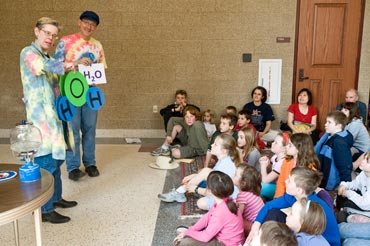Using street theater to channel the lessons of molecules
NEW ORLEANS — Molecules, any chemist will tell you, have lots to teach us.
Giving voice to the lessons of molecules and other props of science, as the lamentable state of science literacy in the United States attests, is no easy task.

Assistant scientist with the College of Engineering Christopher Babiarz (right) and Madison Area Technical College chemistry and creative writing/drama instructor Holly Walter Kerby (left) perform their "Science-in-a-Box " educational theater skit in the Mechanical Engineering building at Science Expeditions on April 5, 2008.
Photo: Bryce Richter
But a novel project by a collaboration of scientists and educators from the UW–Madison and the Madison Area Technical College (MATC) is making molecules and atoms the stars of a project to use theater to teach children the basics of science.
The project, funded by the National Science Foundation (NSF), is really about creating a tool, a model program that can be adapted by teachers and others to channel basic concepts of science to young children. The idea, says Holly Walter Kerby, a Madison playwright and an MATC instructor of chemistry and creative writing/drama, is to adapt the techniques of theater — theme, character and dramatic question — to teaching science to young people.
"Those are skills playwrights use and they transfer nicely to science," says Kerby, who developed the "Science-In-A-Box" initiative with UW–Madison environmental chemist Christopher Babiarz. Babiarz described the project here today at a meeting of the American Chemical Society.
Designed for younger audiences, children ages 10 and younger, Science-In-A-Box productions hinge on elemental concepts and conveying the process of scientific discovery. As its name implies, a main character is a large box, a convenient dispenser of atoms and other props and, through a slide whistle, dramatic punctuation.
A Science-In-A-Box production, say Kerby and Babiarz, isn’t just about spectacle. It is more about conveying overarching ideas about science, and can be tailored to all kinds of science, not just chemistry.
The key, they say, is keeping things simple and fun, and using a dramatic presentation to convey specific ideas. For example, children in the audience learn what happens to water when it boils by acting out the part of water molecules.
Beyond such basic ideas, an emphasis for Babiarz, Kerby and their colleagues is promoting, in a fun and interactive way, the basics of the scientific method: asking questions, making observations, forming hypotheses and conducting experiments.
According to Kerby, many teachers already have an ingrained sense of how to use theatrical techniques to teach, but the Science-In-A-Box model provides a pedagogical framework: "Teachers already have a sense of these tools. We’re just formalizing it."
So far, the approach seems to be working, according to Joanne Cantor, a UW–Madison professor emerita of communication arts and the evaluator for the project.
"More than twice as many kids understood the concepts after the Science-In-A-Box performances than before," Cantor says. "They’re showing that they get it. The kids aren’t just riveted on the fun part, but on the scientific questions and answers."
What’s more, Cantor’s evaluations show that children walk away from the performance with an enhanced appreciation for science. "They significantly increase their belief that science is fun. The (performance) is teaching them concepts they can appreciate and feel good about."
The ultimate goal of the project, say Babiarz and Kerby, is to create something that can be easily adapted to both the classroom and informal settings such as children’s museums, after-school programs, farmers’ markets and shopping malls.
"It’s not our goal to be a traveling science show," Kerby explains. "People in other communities can put these shows on rather cheaply and without too much trouble."
The main thing, notes Babiarz, is framing the scientific question, and playing out the process of science in a way that helps the very young get the big picture of how science gets done, and that fun can be had along the way.
Tags: outreach



